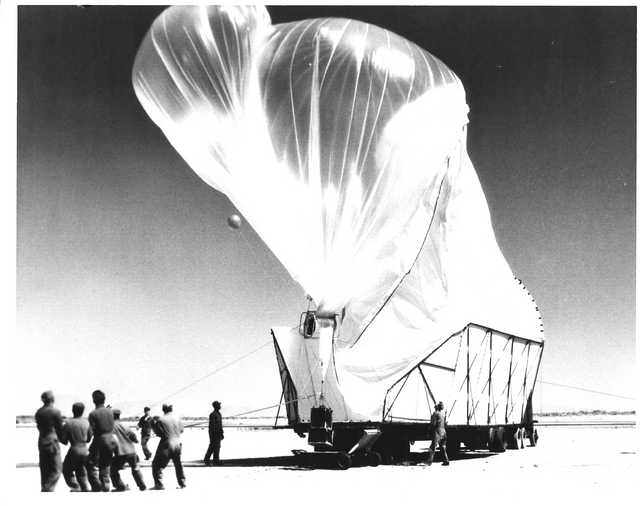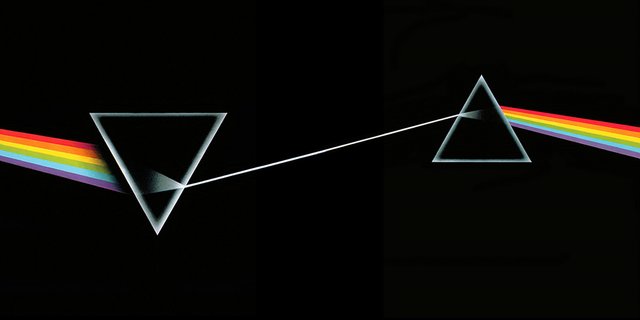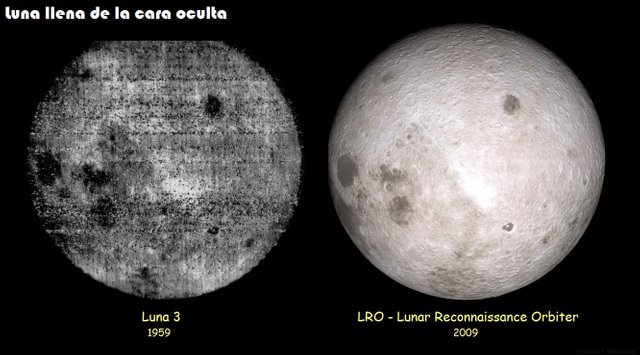The Genetrix Project and Luna 3
Spies, Surveillance, Sabotage
When the cold war era comes most people come to think of sabotage, spying, spy satellites, secret government projects, and of course the space race. We often hear about many great achievements human race has completed, but often we do not get told the story of how such things come to be. So what I have to offer today is a little piece of history that will try to entice and fascinate you enough, just to get a bit of encouragement to get into the STEM field.
The Genetrix Project
Moby Dick and it’s Development

[source]
Our story begins with the precursor to the Genetrix Project, The Moby Dick [1952], these balloons were a bit more innocent compared to their spy-balloon grandchild and only tracked the high altitude wind currents. Not only did they serve that purpose but they also provided a cover for the future spying effort. The program had numerous name changes until it matured in 1954. This caused for a larger scale production of balloons, but this time with cameras. C-119 crews were given training to catch the package from mid air/water, the crews were given “Meteorological Survey” sufix as for further cover for the mission. [1]
Balloon Specifications
The balloons compared to their meteorological predecessor, had 200 kilograms of equipment compared to 20 kilograms respectively. The equipment was in something that could be described as a gondola around the size of a fridge. The humongous balloons holding these were 20 stories high and required new plastics to hold the helium (source 1 does contradict the gas used, which is hydrogen [1]) in as the balloon was 1 hundredth of a millimeter thick. The balloons at their widest point were 30 meters. The balloons themselves would be floating around at a height of approximately 16,800 meters, so they are just out of the reach of the russian fighters. [2] [3]
Preparation and Deployment

[source]
The Balloons were originally going to be be sent from Scotland. But the poor weather caused program to become more decentralized in the sense of locations the balloons were sent from. The balloons were instead sent from western europe and turkey, while the collection crews were stationed in Japan, Philippines, Midway Islands, and also Alaska. In early January 1956, the program received the go ahead. [1]
Set and fly
At this point the program get it’s official and permanent name “Genetrix”. On January 10th the first wave balloons was launched, 8 from turkey and 1 from germany. From this day the quotas were raised to 10 balloon launches per day. The balloons which were supposed to be invisible to the Soviet Radar Systems, didn’t uphold as the gondola’s had a 91 cm bar which corresponded with wavelenght of the token early warning system [2] . So on the second week the Soviet pilots managed effectively intercept massive portions of these balloons. So much that the balloon launches were raised from 10 to 20, and then all the way to 40 on 25th of January. But no balloons managed to make its way to recovery points for the following week. The whole operation only lasted 27 days and it was on stopped on 7th of February. [1]
Results and the Interesting Aftermath
This is where it gets quite bit more interesting but first I will get the boring details out for those who really want to know what the result of the program is. Out of the planned 2500 balloon launches that were supposed to span to June 1956. Only 516 were launched with only 12 operational models being recovered in friendly areas. Only 40 gondolas had images obtained from them. The only interesting thing retrieved from this was a nuclear facility located at Dononovo. [1]
While this program had been a failure for the United States, it became a valuable asset for the Soviet Union’s Space Program. The gondolas cameras contained a special film which was highly resistant to temperature change and radiation. The Soviet Union tried to develop their own film for their Luna 3 Program, but this instead this gave them a new opportunity to seize the development and reuse the film from the Genetrix Project on their cameras on Luna 3. [1] [2]
[3]
[4]
Luna 3
Nature of the Cold War
What I’ve just described previously hopefully encaptures the nature of the cold war, and this is not the only encounter where each side accidently helped one another. The Luna program did not have the best history for successful launches, and the limited amount of film must’ve put a lot of pressure on the Program itself [5]](https://en.wikipedia.org/wiki/Luna_programme). But fortunately the historic first launch of Luna 3 was successful.
Luna’s Mission

[source] kudos if you get the reference
The Mission of Luna 3 was to photograph the dark side of the moon, this was proposed by Keldysh January 1958 . The probe reached a perigee of approx 40,000 km, and took pictures as far as 100,000km from the moon. The probe managed to capture 29 images of the far side of moon covering 70% of it . The probe could not be physically recovered nor could the photographs. So instead there was an inbuilt dark room to process photographs, the transmitting process of the photographs was incredibly complex during the time. A cathode ray tube would produce light on the image, this would project it on a photoelectric multiplayer which turned the light’s intensity into a radio signal, the process of downloading the 17 photographs that were retrieved took 25 hours [6]
[7] [10] [11].
Luna 3’s results and what they mean

[source]
During the time of Luna 3 it has been speculated that that the far side will be no more different from the tidally locked side, however this hypothesis was wrong. Comparing the two sides the first side has a lot more of Lunar Mare [8], this has opened up many more questions than it has answered (such is the wonderful and unfortunate nature of science). However most of the research today points that the formation of Lunar Mare only one hemisphere is due to something known as the “Giant-Impact Hypothesis” [8] [9]. The Brief rundown is
This Giant Impact Hypothesis suggests that the outer layers of the Earth and the object were flung into space and eventually formed the moon.
Shortly after the giant impact, the Earth and the moon were very hot, said researchers. The Earth and the impact object did not just melt; parts of them vaporized, creating a disk of rock, magma and vapor around the Earth.
The geometry was similar to the rocky exoplanets recently discovered very close to their stars, said Wright. The moon was 10 to 20 times closer to Earth than it is now, and the researchers found that it quickly assumed a tidally locked position with the rotation time of the moon equal to the orbital period of the moon around the Earth. The same real estate on the moon has probably always faced the Earth ever since. Tidal locking is a product of the gravity of both objects.
The moon, being much smaller than Earth cooled more quickly. Because the Earth and the moon were tidally locked from the beginning, the still hot Earth – more than 2500 degrees Celsius – radiated towards the near side of the moon. The far side, away from the boiling Earth, slowly cooled, while the Earth-facing side was kept molten creating a temperature gradient between the two halves.
This gradient was important for crustal formation on the moon. The moon’s crust has high concentrations of aluminum and calcium, elements that are very hard to vaporize.
Aluminum and calcium would have preferentially condensed in the atmosphere of the cold side of the moon because the nearside was still too hot. Thousands to millions of years later, these elements combined with silicates in the moon’s mantle to form plagioclase feldspars, which eventually moved to the surface and formed the moon’s crust. The far side crust had more of these minerals and is thicker.
The moon has now completely cooled and is not molten below the surface. Earlier in its history, large meteoroids struck the nearside of the moon and punched through the crust, releasing the vast lakes of basaltic lava that formed the nearside maria that make up the characteristic man in the moon features.
Meanwhile, when meteoroids struck the far side of the moon, in most cases the crust was too thick and no magmatic basalt welled up, creating the dark side of the moon with valleys, craters and highlands, but almost no maria.
[8]
Another important and significant outcome of the Luna 3, not only it is the first spacecraft to photograph the far side of the moon. It is the first spacecraft to also be fully powered by solar energy [6] [10].
Personal Comments
Hopefully I will get the results I want to achieve, which are. Get more people interested in science and STEM, by explaining the process of the achievement was gotten, not what the achievement was about. Nonetheless if you are interested in writing such as this about Science, History or a bit of politics then you should be interested in following my account as I will be creating posts in all 3 fields. Now I shall finish this post on this notice: Please leave criticism of my writing and create constructive comments that will drive conversation much further.
Sources that I’ve used and some that I’ve not found place for them
http://stratocat.com.ar/stratopedia/28.htm
https://www.theguardian.com/science/2002/jan/10/physicalsciences.highereducation
http://kik-sssr.ru/Hist_2_FirstLunaProb.htm
https://www.popsci.com/blog-network/vintage-space/our-first-look-moons-far-side#page-2
http://earthsky.org/space/dark-side-of-the-moon-mystery-solved
https://en.wikipedia.org/wiki/Giant-impact_hypothesis
https://www.diyphotography.net/the-weird-story-of-the-us-sending-camera-coffins-to-space-and-the-soviets-repurposing-them-into-moon-fax-cameras/
https://en.wikipedia.org/wiki/Project_Genetrix
https://en.wikipedia.org/wiki/Luna_programme
https://en.wikipedia.org/wiki/Luna_3
https://nssdc.gsfc.nasa.gov/nmc/masterCatalog.do?sc=1959-008A
https://seanmunger.com/2014/10/07/the-dark-side-of-the-moon-revealed-the-flight-of-luna-3/
https://cosmosmagazine.com/space/dark-side-of-the-moon-revealed-half-a-century-ago
https://en.wikipedia.org/wiki/Lunar_mare
sharing technology costs a lot less than making it yourself, and stealing is the next best thing
good post
Thanks make sure to follow :D
Well that's an interesting set o' developments, I thought I heard somethin' similar to that 'n' well now I found it. Tbh, this post deserves to be lik'd by every viewer.
...This stuff is fascinating. Man, I'm gonna lose some hours now. Thanks! Resteemed!
No problem, I'm hoping to put out more content like this.
@originalworks
The @OriginalWorks bot has determined this post by @nonationnoborder to be original material and upvoted it!
To call @OriginalWorks, simply reply to any post with @originalworks or !originalworks in your message!
This post has received a 0.11 % upvote from @drotto thanks to: @steemstem-bot.
I think spies are always lurking even today
Well done! This post has received a 33.33 % upvote from @litasio thanks to: @steemstem-bot. Whoop!
If you would like to delegate to the @LitasIO you can do so by clicking on the following link: 10SP
I'm upvoting this at 100%.
Great article. I'm a bit of an av nerd so I enjoy stuff like this.
Fantastic, why not follow and join in on the ride. Make sure to go onto my sources, they cover more of the A/V part and telemetry there.
I just did :)
Congratulations @nonationnoborder, this post is the second most rewarded post (based on pending payouts) in the last 12 hours written by a Dust account holder (accounts that hold between 0 and 0.01 Mega Vests). The total number of posts by Dust account holders during this period was 9024 and the total pending payments to posts in this category was $4039.71. To see the full list of highest paid posts across all accounts categories, click here.
If you do not wish to receive these messages in future, please reply stop to this comment.